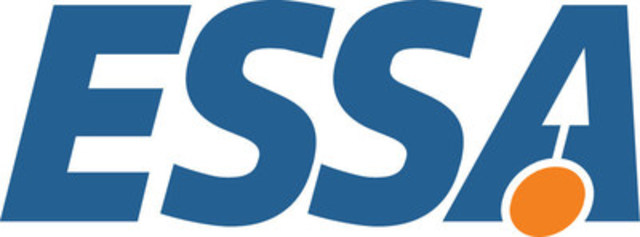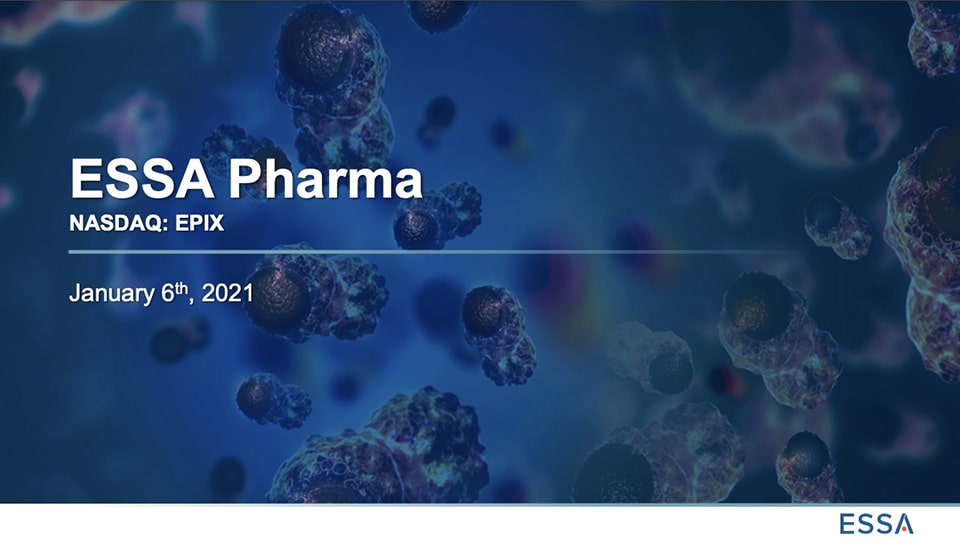

HOUSTON and VANCOUVER, Feb. 12, 2016 /CNW/ - ESSA Pharma Inc. ("ESSA" or the "Company") (TSX: EPI, NASDAQ: EPIX) today reported financial results for the three months ended December 31, 2015. Amounts, unless specified otherwise, are expressed in United States dollars and in accordance with International Financial Reporting Standards ("IFRS").
First Quarter Highlights and Corporate Update
Enrollment of First Patient in Phase 1/2 Clinical Trial
In November 2015, the Company opened its first clinical trial sites and enrolled the first patient in the Phase 1/2 clinical study of EPI-506. In its Phase 1/2 clinical trial, ESSA intends to investigate the safety, tolerability, maximum tolerated-dose, pharmacokinetics, and efficacy of EPI-506 in patients with metastatic castrate resistant prostate cancer who have failed abiraterone or enzalutamide therapy or both.
Details relating to the Phase 1/2 clinical trial are now available on the US National Institutes of Health clinical trials website (https://clinicaltrials.gov).
Private Placement
On January 14, 2016, the Company completed a private placement (the "2016 Financing") of 4,545,452 units of the Company at $3.30 per unit for aggregate gross proceeds of approximately $15,000,000.
Each unit consisted of one common share of the Company (a "Common Share"), one seven-year cash and cashless exercise warrant and one-half of one two-year cash exercise warrant (such warrants, together, the "2016 Warrants"). Each of the 2016 Warrants has an exercise price of $3.30.
The financing was led by Clarus Lifesciences III, L.P. ("Clarus"), a new investor in the Company, with participation from Deerfield Management Company and other existing shareholders (the "2016 Financing Participants"). The Company intends to use the net proceeds from the 2016 Financing for general corporate purposes, including funding research and development, preclinical and clinical expenses, and corporate costs.
In connection with the 2016 Financing, the Company filed a prospectus supplement (the "Prospectus Supplement") to the Company's existing base shelf prospectus with the securities regulatory authorities in British Columbia, Alberta, and Ontario and the United States Securities and Exchange Commission (the "SEC"). The Prospectus Supplement covers resales by the 2016 Financing Participants, from time to time, of up to 4,545,452 Common Shares and up to 6,818,178 Common Shares issuable on the exercise of the 2016 Warrants.
In addition, upon closing of the 2016 Financing, Richard Glickman, Marianne Sadar, Raymond Andersen and Bob Rieder, who in the aggregate controlled approximately 9,482,800 Common Shares constituting 41.9% of the issued and outstanding Common Shares on a non-diluted basis as at the date thereof, entered into a voting agreement (the "Voting Agreement") with Clarus providing that such shareholders will vote against certain change of control transactions, unless Clarus consents otherwise, and support Clarus' nominees to the board of directors of the Company. Under the Voting Agreement, the applicable shareholders will be prohibited from transferring 50% of the Common Shares held by them on the effective date, with limited exceptions. The provisions of the Voting Agreement relating to change of control transactions and non-transferability of Common Shares will expire, at the latest, upon the six-month anniversary of the public release of the results of the completed Phase 2 portion of the Phase 1/ 2 clinical trial of EPI-506 by the Company or the public release of the results of the completed Phase 2 portion of an alternative program that is approved by the board of directors and the provisions relating to the Clarus nominees will continue for so long as Clarus is entitled to nominate directors to the Company's board of directors.
Additional details with respect to the 2016 Financing can be found in the material change report of the Company dated January 15, 2016.
Senior Leadership Changes
On January 7, 2016, Dr. David Parkinson was appointed as the Company's President and Chief Executive Officer.
David Parkinson has significant experience in the development of novel approaches to cancer therapy. He has served as Vice President, Global Clinical Oncology for Novartis, and as Vice President, Oncology Development at Amgen. During his tenures at Amgen and Novartis, Dr. Parkinson was responsible for clinical development activities leading to a series of successful global drug registrations for important cancer therapeutics, including Gleevec, Femara, Zometa, Kepivance, and Vectibix. In addition, Dr. Parkinson has also served as the Sr. Vice President, Oncology Research and Development at Biogen Idec and as the CEO of the diagnostics company Nodality. Most recently he has been serving as a venture partner at New Enterprise Associates, Inc. (NEA).
Dr. Parkinson replaces Mr. Robert Rieder who announced his departure from the Company and resignation from the Board of Directors.
On January 14, 2016, effective on the closing of the Private Placement, Scott Requadt, Managing Director of Clarus Ventures, LLC, was appointed to the board of directors of the Company.
Summary Results
ESSA recorded a net loss of $4.0 million ($0.18 per Common Share) for the three months ended December 31, 2015, compared to a net loss of $1.3 million ($0.08 per Common Share) for the three months ended December 31, 2014.
Research and Development ("R&D") expenditures for the period were $3.2 million compared to $0.6 million for 2014. R&D expenditures for the three months ended December 31, 2014 were $1.9 million before recognition of recoveries from a grant from the Cancer Prevention and Research Institute of Texas of $1.3 million.
The increase in R&D expenditures is primarily due to manufacturing and clinical costs incurred as the Company transitions into the clinical development stage with respect to clinical candidate EPI-506. In the three months ended December 31, 2015, the Company commenced enrolling patients into its Phase 1/2 clinical trial. The composition of costs in R&D has therefore evolved to include additional staff salaries and away from preclinical and Investigational New Drug ("IND") application work in the prior period. The Company has received approval from the U.S. Food and Drug Administration for its IND application and a 'no objection letter' from the Health Protection Branch of Health Canada for its Clinical Trial Authorization application.
General and administration expenditures for the three months ended December 31, 2015 were $1.2 million compared to $0.7 million for the comparative period. The increase was primarily due to increased activity as a public corporate entity as the Company became a reporting issuer December 23, 2014. Since December 31, 2014, the Company has grown substantially to support the pursuit of the development of EPI-506.
Liquidity and Outstanding Share Capital
Working capital as at December 31, 2015 was $0.6 million. Shortly after period end, the Company closed the 2016 Financing, which will provide funding to execute the Company's Phase 1 portion of the Phase 1/2 clinical trial. The Phase 1 portion is anticipated to complete in the second half of calendar 2016. Management continues to consider sources of additional financing which would assure continuation of the Company's operations and research programs.
As of December 31, 2015, the Company had 22,630,047 Common Shares issued and outstanding, 3,493,519 Common Shares issuable upon the exercise of outstanding stock options at a weighted-average exercise price of CAD$1.94 per share, and 281,363 Common Shares issuable upon the exercise of outstanding warrants at a weighted-average exercise price of CAD$3.65 per share.
As of the date of this release, the Company has 27,409,223 Common Shares issued and outstanding following the 2016 Financing, a further 3,833,519 Common Shares issuable upon the exercise of outstanding stock options at a weighted-average exercise price of CAD$2.71 per share, and 7,099,541 Common Shares issuable upon the exercise of outstanding warrants at a weighted-average exercise price of CAD$4.55 per share.
About ESSA Pharma Inc.
ESSA Pharma is a clinical-stage pharmaceutical company focused on developing novel and proprietary therapies for the treatment of castration-resistant prostate cancer ("CRPC") in patients whose disease is progressing despite treatment with current therapies. ESSA believes that its product candidate, EPI-506, can significantly expand the interval of time in which patients suffering from CRPC can benefit from hormone-based therapies. EPI-506 acts by disrupting the androgen receptor ("AR") signaling pathway, which is the primary pathway that drives prostate cancer growth. We have shown that EPI-002, the primary metabolite of EPI-506, prevents AR activation by binding selectively to the N-terminal domain ("NTD") of the AR. A functional NTD is essential for activation of the AR. Blocking the NTD prevents activation of the AR by all of the three known mechanisms of activation. In pre-clinical studies, blocking the NTD has demonstrated the capability to overcome the known AR-dependent mechanisms of CRPC. ESSA was founded in 2009 and is located in Houston, Texas, and Vancouver, British Columbia.
About Prostate Cancer
Prostate cancer is the second-most commonly diagnosed cancer among men and the fifth most common cause of male cancer death worldwide (Globocan, 2012). Adenocarcinoma of the prostate is dependent on androgen for tumor progression and depleting or blocking androgen action has been a mainstay of hormonal treatment for over six decades. Although tumors are often initially sensitive to medical or surgical therapies that decrease levels of testosterone (for example, Androgen Deprivation Therapy), disease progression despite castrate levels of testosterone generally represents a transition to the lethal variant of the disease metastatic castration-resistant prostate cancer (mCRPC) and most patients ultimately succumb to the illness. The treatment of mCRPC patients has evolved rapidly over the past five years; despite these advances, additional treatment options are needed to improve clinical outcomes in patients, particularly those who fail existing treatments including abiraterone or enzalutamide, or those that have contraindications to receive those drugs. Over time, patients with mCRPC generally experience continued disease progression, worsening pain, leading to substantial morbidity and limited survival rates. In both in vitro and in vivo studies, ESSA's novel approach to blocking the androgen pathway has been shown to be effective in blocking tumor growth when current therapies are no longer effective.
Cautionary Note Regarding Forward-Looking Statements
Certain statements in this news release contain forward-looking information within the meaning of the Private Securities Litigation Reform Act of 1995 and/or Canadian securities laws that may not be based on historical fact, including without limitation, statements containing the words "believe", "may", "plan", "will", "estimate", "continue", "anticipate", "intend", "expect" and similar expressions. Forward-looking statements in this news release include, but are not limited to, statements regarding the intended purpose of ESSA's Phase 1/2 clinical trial in respect of EPI-506, the intended use of proceeds from the 2016 Financing and the impact of the 2016 Financing on the execution of the Company's Phase 1 portion of the Phase 1/2 clinical trial in respect of EPI-506.
Forward-looking statements and information are subject to various known and unknown risks and uncertainties, many of which are beyond the ability of ESSA to control or predict, and which may cause ESSA's actual results, performance or achievements to be materially different from those expressed or implied thereby. Such statements reflect ESSA's current views with respect to future events, are subject to risks and uncertainties and are necessarily based upon a number of estimates and assumptions that, while considered reasonable by ESSA as of the date of such statements, are inherently subject to significant medical, scientific, business, economic, competitive, political and social uncertainties and contingencies. In making forward-looking statements, ESSA may make various material assumptions, including but not limited to assumptions regarding ESSA's strategic plan and business objectives, clinical trials of ESSA continuing as intended and the expected cash position of ESSA.
Forward-looking information is developed based on assumptions about such risks, uncertainties and other factors including, among others, the factors discussed in or referred to under the heading "Risk Factors" in ESSA's Annual Report on Form 20-F for the year ended September 30, 2015 which is available under ESSA's profile on SEDAR at www.sedar.com and on EDGAR at www.sec.gov. Forward-looking statements are made based on management's beliefs, estimates and opinions on the date that statements are made and ESSA undertakes no obligation to update forward-looking statements if these beliefs, estimates and opinions or other circumstances should change, except as may be required by applicable law. Readers are cautioned against attributing undue certainty to forward-looking statements.
SOURCE ESSA Pharma Inc
Image with caption: "ESSA Pharma Inc. (CNW Group/ESSA Pharma Inc)". Image available at: http://photos.newswire.ca/images/download/20160212_C8865_PHOTO_EN_620156.jpg

